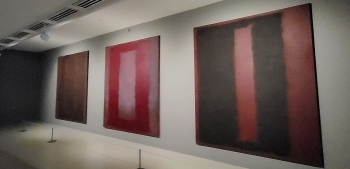The artist Mark Rothko in Cornwall
MANY PEOPLE MEDITATE profoundly in front of paintings by the American artist Mark Rothko (1903-1970). I am not one of those people. I can recognise his work and appreciate its originality, but he is not amongst my favourite 20th century artists.
When visiting the branch of the Tate Gallery in Cornwall’s St Ives at the beginning of July 2024, I viewed a small exhibition of painted panels created by Rothko. In 1958, he was commissioned to paint them for the Four Seasons restaurant in the Seagram Building in New York City. In the summer of 1959, he took a break from painting this series of pictures, and visited England. The painter Peter Lanyon invited Rothko to his home in St Ives in Cornwall. During his stay, he met other artists based in the West Country including Alan Davie, Paul Feiler, Patrick Heron, and Terry Frost. Rothko’s visit to St Ives was a factor that helped change his mind about displaying the paintings he was creating for the Four Seasons restaurant. It has been recorded that he said that the restaurant was:
“… a place where the richest bastards of New York will come to feed and show off.” (theartnewspaper.com, 4th of April 2024).

In 1969, Rothko donated nine of the paintings, originally destined for the restaurant, to the Tate Gallery. Seven others can be viewed at the Kawamura Museum of Modern Art in Japan, and another thirteen are housed at the National Gallery of Art in Washington DC. The rest are owned by his children.
Usually, the paintings currently being displayed at the Tate in St Ives are to be found in a dedicated room in London’s Tate Modern. Currently, the room where they are usually stored in Tate Modern is being used to host an exhibition by another artist (Joan Mitchell). The Seagram murals will remain in St Ives until January 2025.
We visit St Ives regularly. Its branch of the Tate is one of several artistic attractions we visit in the town. Although it contains some great artworks, I am not fond of its architecture. I am glad we visited again because had we not done so, I would not have known about Rothko’s holiday in St Ives, and the influence it had on his decision not to display his paintings in a fancy restaurant in New York City.



